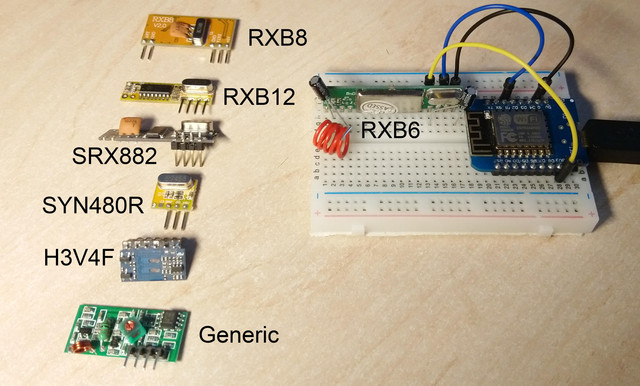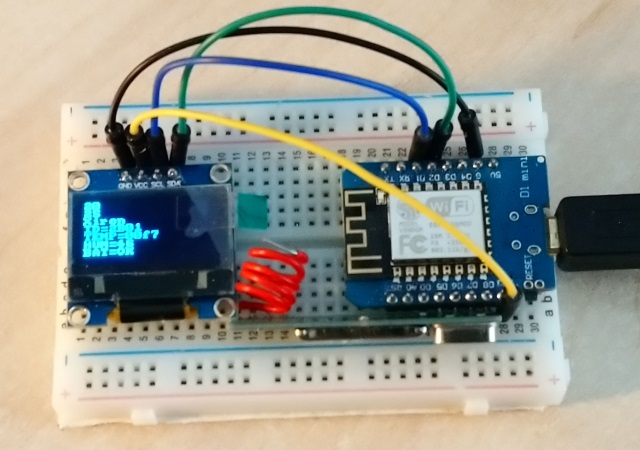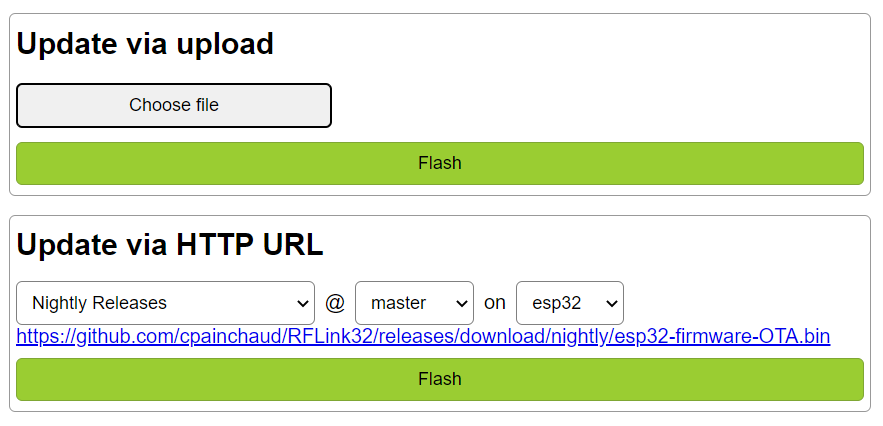This is a Radio Frequency to MQTT/Serial/TCP gateway built for ESP32 and ESP8266 boards (see #MCU for more).
It receives and decodes OOK 433MHz signals from your sensors, alarms and pushes them over MQTT/TCP/Serial. For some devices it can also send commands to control them.
This project is forked from RFLink-ESP (for ESP8266), which itself is forked from the original RFlink project "Release 29" for Arduino.
This fork provides additional features:
- Fully (almost) configurable from a web interface whilst retaining the CLI.
- No recompilation for most options which are configurable at runtime and saved in Flash.
- More advanced debugging and troubleshooting helpers.
- Restructured source code with namespaces and classes (Work in Progress)
We extensively use ESP32 dev kits.
This is the default settings in Platformio.ini and RFLink.h files.
You may also use other ESP8266/ESP8255 based boards when there are no pin limitations. NodeMCUv2 is known to work.
As a starting point, you can use the RXB6 receiver which is a simple and stable 3.3v component - it is easy to find and cheap. Many other receivers are also supported.
Avoid using generic noname receivers!
For more advanced behavior and reliability, the following receivers are also supported when used with an ESP32 board:
- SX1278
- SX1276
- RFM69CW
- RFM69HCW
- CC1101
These advanced receivers require a few pins to be connected to the host. The recommended pin assignments are:
| Name | ESP32 | SX1278/6 | RFM69(H)CW | CC1101 |
|---|---|---|---|---|
| 3v3 | VCC | 3.3V | VCC | |
| GND | GND | GND | GND | |
| 18 | SCK | SCK | SCK | |
| 19 | MISO | MISO | MISO | |
| 23 | MOSI | MOSI | MOSI | |
| pins::RX_RESET | 4¹ | NRESET | RESET | |
| pins::RX_CS | 5¹ | NSS | NSS | CSN |
| pins::RX_DATA pins::TX_DATA |
26¹ | DIO2 | DIO2 | GDO0 |
¹ These must be configured in the web portal, values suggested here are proven to work reliably.
You can use an OLED display. We used a SSD1306 128x64 I2C screen in our tests.
This is highly experimental and therefore not enabled by default.
We strongly recommend using the PlatformIO IDE but you can alternatively use the Arduino IDE 1.8.10.
We use Arduino Core for ESP8266.
In addition to the core libraries, the following are also in use:
- PubSubClient for MQTT messaging https://github.com/knolleary/pubsubclient
- u8g2/u8x8 library for OLED display https://github.com/olikraus/u8g2
Many features are not enabled by default or can be disabled for various reasons like firmware size or compatibility.
There are 3 types of OTA to update your firmware:
RFLINK_OTA_ENABLEDwe recommend that you enable a password for this method or anyone on your network could push a new firmware to the device.RFLINK_OTA_PASSWORD="my_password_here"orRFLINK_OTA_PASSWORD='"'${sysenv.OTA_SEC}'"'inplatformio.iniwith an environment variable calledOTA_SEC
The device will download new firmware from a specified URL.
- RFLINK_AUTOOTA_ENABLED
- AutoOTA_URL in
Credentials.hor inplatformio.ini
A firmware file can be uploaded via the Config Portal's Firmware page.
The Config Portal web ui is located in its own repository.
rflink32 / 433mhz
- Pin setup has to be done via the Config Portal when it is active.
- For safety and simplicity all pins are inactive by default.
- Decoupling capacitors and antenna can be added to improve results.
Simple RX pin wiring:
| Name | D1 mini | RXB6 |
|---|---|---|
| PIN_RF_TX_VCC | D5 | 5 VCC |
| PIN_RF_TX_NA | D6 | 6 DER |
| PIN_RF_TX_DATA | D7 | 7 DAT |
| PIN_RF_TX_GND | D8 | 8 GND |
- ESP8266 can't draw more than 12mA on a GPIO pin.
- Some receivers have current spikes bigger than that (eg RXB12).
- This leads to a non working receiver or non starting ESP.
Safe alternative wiring:
| Name | D1 mini | RXB6 |
|---|---|---|
| PIN_RF_TX_VCC | 3v3 | 5 VCC |
| PIN_RF_TX_NA | N/A | 6 DER |
| PIN_RF_TX_DATA | D7 | 7 DAT |
| PIN_RF_TX_GND | GND | 8 GND |
Special thanks to: Axellum, Etimou, Schmurtz, Zoomx



